| Listing 1 - 10 of 11 | << page >> |
Sort by
|
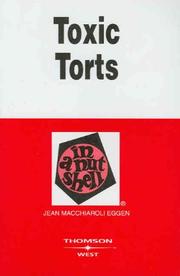
ISBN: 0314159053 Year: 2005 Publisher: Saint Paul Thomson West
Abstract | Keywords | Export | Availability | Bookmark
 Loading...
Loading...Choose an application
- Reference Manager
- EndNote
- RefWorks (Direct export to RefWorks)
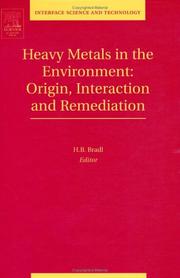
ISSN: 15734285 ISBN: 0120883813 9786610630462 1280630469 008045500X 9780120883813 9780080455006 Year: 2005 Publisher: Amsterdam : Elsevier Academic Press,
Abstract | Keywords | Export | Availability | Bookmark
 Loading...
Loading...Choose an application
- Reference Manager
- EndNote
- RefWorks (Direct export to RefWorks)
Excessive levels of heavy metals can be introduced into the environment, for example, by industrial waste or fertilizers. Soil represents a major sink for heavy metals ions, which can then enter the food chain via plants or leaching into groundwater. In Heavy Metal Ions in the Environment, the author looks at where heavy metals ions come from, how they interact with the environment and how they can be removed from the environment - by a process known as remediation. This book serves as a valuable addition to an increasingly important field of study, which is, at present, served by a limited nu
Heavy metals --- Heavy metals. --- Toxic metals --- Metals --- Poisons --- Environmental aspects.
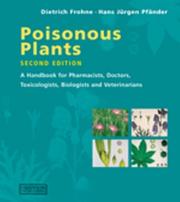
ISBN: 9781874545941 1874545944 Year: 2005 Publisher: London: Manson,
Abstract | Keywords | Export | Availability | Bookmark
 Loading...
Loading...Choose an application
- Reference Manager
- EndNote
- RefWorks (Direct export to RefWorks)
Poisonous plants --- Plantes --- Plantes vénéneuses --- Toxicology --- Identification --- Toxicologie --- Plants, Toxic --- Plant Poisoning --- ETH Ethnobotany & Economic botany --- Europe --- ethnobotany & economic botany --- poisonous plants --- toxicology --- Plantes vénéneuses --- Poisonous plants - Toxicology --- Poisonous plants - Identification --- PLANTS, TOXIC --- PLANT POISONING --- THERAPY --- VETERINARY
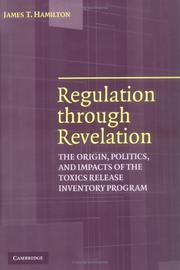
ISBN: 9780521855303 9780511614835 9780521389891 9780511345340 0511345348 0511614837 0521855306 0521389895 1107155347 9781107155343 1281108650 9781281108654 9786611108656 6611108653 0511345003 9780511345005 0511344643 9780511344640 0511344252 9780511344251 0511568525 9780511568527 0521855306 Year: 2005 Publisher: Cambridge ; New York : Cambridge University Press,
Abstract | Keywords | Export | Availability | Bookmark
 Loading...
Loading...Choose an application
- Reference Manager
- EndNote
- RefWorks (Direct export to RefWorks)
Information provision is increasingly being used as a regulatory tool. The US Environmental Protection Agency's Toxics Release Inventory (TRI) Program required facilities that handle threshold amounts of specific chemicals to report yearly their releases and transfers of these toxic substances. The TRI data have become the yardstick by which regulators, investors, environmental organizations, and local community groups measure company environmental performance. This book, which was originally published in 2005, tells the story of the TRI from its origin and implementation to its revision and retrenchment. The mix of case study and quantitative analysis shows how the TRI operates and how the information provided affects decisions in both the public and private sectors. The lessons drawn about the operation of information provision programs should be of interest to multiple audiences.
Pollution --- Hazardous wastes --- Environmental policy --- Hazardous waste disposal --- Poisonous wastes --- Toxic waste disposal --- Toxic waste release --- Toxic wastes --- Waste disposal --- Wastes, Hazardous --- Factory and trade waste --- Hazardous substances --- Refuse and refuse disposal --- Chemical pollution --- Chemicals --- Contamination of environment --- Environmental pollution --- Contamination (Technology) --- Asbestos abatement --- Bioremediation --- Environmental engineering --- Environmental quality --- Hazardous waste site remediation --- In situ remediation --- Lead abatement --- Pollutants --- Government policy --- Environmental aspects --- Toxics Release Inventory Program (U.S.) --- TRI Program (U.S.) --- United States. --- Social Sciences --- Political Science
Book
ISBN: 2743008067 9782743008062 Year: 2005 Publisher: Paris: Technique et Documentation Lavoisier,
Abstract | Keywords | Export | Availability | Bookmark
 Loading...
Loading...Choose an application
- Reference Manager
- EndNote
- RefWorks (Direct export to RefWorks)
Poisonous plants --- Livestock poisoning plants --- Plantes vénéneuses --- Plantes --- Plantes vénéneuses pour le bétail --- Identification --- Toxicology --- Toxicologie --- Agrotechnology and Food Sciences. Toxicology --- Toxicology (General) --- ETH Ethnobotany & Economic botany --- animal health --- animal poisoning --- ethnobotany --- handbooks --- human health --- medicinal plants --- phytochemistry --- plant use --- poisonous plants --- toxic plants --- toxicology --- Toxicology (General). --- Plantes vénéneuses --- Plantes vénéneuses pour le bétail --- Acqui 2006 --- Poisoning --- Medicinal plants --- Plants, toxic --- identification --- medical treatment --- symptoms --- toxicity --- chemical composition --- Plants, Toxic. --- Plants, Toxic --- Medical treatment --- Symptoms --- Toxicity --- Chemical composition --- poisoning. --- toxicity.
Book
ISBN: 9780743456081 Year: 2005 Publisher: New York, N.Y. Washington Square Press
Abstract | Keywords | Export | Availability | Bookmark
 Loading...
Loading...Choose an application
- Reference Manager
- EndNote
- RefWorks (Direct export to RefWorks)
Everyone needs to love and be loved--even men. But to know love, men must be able to look at the ways that patriarchal culture keeps them from knowing themselves, from being in touch with their feelings, from loving. In The Will to Change, bell hooks gets to the heart of the matter and shows men how to express the emotions that are a fundamental part of who they are--whatever their age, marital status, ethnicity, or sexual orientation. But toxic masculinity punishes those fundamental emotions, and it's so deeply ingrained in our society that it's hard for men to not comply--but hooks wants to help change that. With trademark candor and fierce intelligence, hooks addresses the most common concerns of men, such as fear of intimacy and loss of their patriarchal place in society, in new and challenging ways. She believes men can find the way to spiritual unity by getting back in touch with the emotionally open part of themselves--and lay claim to the rich and rewarding inner lives that have historically been the exclusive province of women. A brave and astonishing work, The Will to Change is designed to help men reclaim the best part of themselves.
Sociology of the family. Sociology of sexuality --- Sexology --- intermenselijke relaties --- toxic masculinity --- intimiteit --- mannen --- liefde --- hooks, bell --- Masculiniteit. --- Feminism --- Love --- Masculinity --- Men --- Patriarchy --- Theory --- Book --- Emotions

ISBN: 0192806009 9780192806000 0191517356 9786612268410 1282268414 1280762896 9786610762897 1435605322 0191004901 0191916412 9780191517358 9781280762895 Year: 2005 Publisher: Oxford ; New York : Oxford University Press,
Abstract | Keywords | Export | Availability | Bookmark
 Loading...
Loading...Choose an application
- Reference Manager
- EndNote
- RefWorks (Direct export to RefWorks)
Mercury, arsenic, antimony, lead, and thallium can be lethal, as many a poisoner knew too well. Emsley explores the gruesome history of these elements and those who have succumbed to them in a fascinating narrative that weaves together stories of true crime, enduring historical mysteries, tragic accidents, and the science behind it all. The colourful cast includes ancient alchemists, kings, leaders, a pope, several great musicians, and a motley crew of murderers. Among the intriguing accounts is that of the 17th century poet Sir Thomas Overbury, who survived four attempts to poison him with mercury but died when given the poison in enema form - under whose direction remains uncertain. Here, too, is detailed the celebrated case of Florence Maybrick, convicted of poisoning her violent husband James with arsenic, but widely believed at the time to be innocent. The question of her guilt is still disputed.
toxines --- popularisering wetenschap --- Criminology. Victimology --- wetenschapsgeschiedenis --- Toxicology --- Heavy Metal Poisoning, Nervous System --- Specialty Uses of Chemicals --- Neurotoxicity Syndromes --- Arsenic Poisoning --- Metals, Heavy --- Toxicology & Public Health --- Poisonous chemicals --- Poisonous substances --- Toxic chemicals --- Toxic substances --- Toxicants --- Toxics --- Poisoning. --- Poisons. --- Toxicology. --- Chemicals --- Medicine --- Pharmacology --- Poisoning --- Poisons --- Bioactive compounds --- Hazardous substances --- Toxicological emergencies --- Therapeutic use. --- History.
Book
Year: 2005 Publisher: [Place of publication not identified] Academic Press Imprint
Abstract | Keywords | Export | Availability | Bookmark
 Loading...
Loading...Choose an application
- Reference Manager
- EndNote
- RefWorks (Direct export to RefWorks)
Noxae --- Age Groups --- Mental Disorders Diagnosed in Childhood --- Toxic Actions --- Persons --- Mental Disorders --- Chemical Actions and Uses --- Psychiatry and Psychology --- Chemicals and Drugs --- Named Groups --- Neurotoxins --- Developmental Disabilities --- Child --- Environmental Pollutants --- Noxae. --- Age Groups. --- Neurodevelopmental Disorders. --- Toxic Actions. --- Persons. --- Mental Disorders. --- Chemical Actions and Uses. --- Neurotoxins. --- Developmental Disabilities. --- Child. --- Environmental Pollutants.
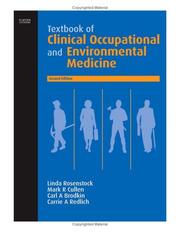
ISBN: 9780721689746 0721689744 9781437713350 1437713351 Year: 2005 Publisher: [Place of publication not identified] Elsevier Saunders
Abstract | Keywords | Export | Availability | Bookmark
 Loading...
Loading...Choose an application
- Reference Manager
- EndNote
- RefWorks (Direct export to RefWorks)
Occupational diseases. --- Industrial hygiene. --- Industrial toxicology. --- Occupational Diseases. --- Occupational Medicine. --- Environmental Pollutants. --- Environmental Exposure. --- Preventive Medicine --- Diseases --- Toxic Actions --- Public Health --- Environmental Pollution --- Environment and Public Health --- Chemical Actions and Uses --- Medicine --- Chemicals and Drugs --- Health Care --- Health Occupations --- Disciplines and Occupations --- Environmental Exposure --- Occupational Diseases --- Environmental Medicine --- Environmental Pollutants --- Occupational Medicine --- Pollutants --- Pollutants, Environmental --- Environmental Pollutant --- Pollutant --- Pollutant, Environmental --- Radiation Exposure --- Medicine, Industrial --- Medicine, Occupational --- Industrial Medicine --- Industry --- Medicine, Environmental --- Environmental Psychology --- Diseases, Occupational --- Occupational Illnesses --- Disease, Occupational --- Illnesse, Occupational --- Illnesses, Occupational --- Occupational Disease --- Occupational Illnesse --- Accidents, Occupational --- Karoshi Death --- Exposure, Environmental --- Environmental Exposures --- Exposures, Environmental --- Sentinel Species --- Health Professions --- Health Occupation --- Health Profession --- Profession, Health --- Professions, Health --- Occupations --- Community-Based Distribution --- Contraceptive Distribution --- Delivery of Healthcare --- Dental Care Delivery --- Distribution, Non-Clinical --- Distribution, Nonclinical --- Distributional Activities --- Healthcare --- Healthcare Delivery --- Healthcare Systems --- Non-Clinical Distribution --- Nonclinical Distribution --- Delivery of Dental Care --- Health Care Delivery --- Health Care Systems --- Activities, Distributional --- Activity, Distributional --- Care, Health --- Community Based Distribution --- Community-Based Distributions --- Contraceptive Distributions --- Deliveries, Healthcare --- Delivery, Dental Care --- Delivery, Health Care --- Delivery, Healthcare --- Distribution, Community-Based --- Distribution, Contraceptive --- Distribution, Non Clinical --- Distributional Activity --- Distributions, Community-Based --- Distributions, Contraceptive --- Distributions, Non-Clinical --- Distributions, Nonclinical --- Health Care System --- Healthcare Deliveries --- Healthcare System --- Non Clinical Distribution --- Non-Clinical Distributions --- Nonclinical Distributions --- System, Health Care --- System, Healthcare --- Systems, Health Care --- Systems, Healthcare --- Medical Specialities --- Medical Specialties --- Medical Specialty --- Specialities, Medical --- Specialties, Medical --- Specialty, Medical --- Medical Speciality --- Speciality, Medical --- Health Workforce --- Pollution, Environmental --- Soil Pollution --- Pollution, Soil --- Community Health --- Environment, Preventive Medicine & Public Health --- Environment, Preventive Medicine and Public Health --- Health, Community --- Health, Public --- Education, Public Health Professional --- Environmental Pollutants, Noxae, and Pesticides --- Toxic Action --- Action, Toxic --- Actions, Toxic --- Medicine, Preventive --- Preventative Care --- Preventative Medicine --- Preventive Care --- Care, Preventative --- Care, Preventive --- Medicine, Preventative --- Disease --- Preventive Health Services --- Primary Prevention --- prevention & control --- Preventive Medicine. --- Disease. --- Toxic Actions. --- Public Health. --- Environmental Pollution. --- Environment and Public Health. --- Chemical Actions and Uses. --- Medicine. --- Delivery of Health Care. --- Health Occupations. --- Environmental Medicine.
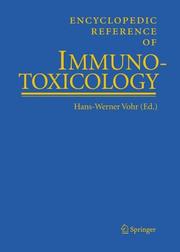
ISBN: 3540441727 3540278060 1281329932 3540334440 Year: 2005 Publisher: Berlin, Heidelberg : Springer Berlin Heidelberg : Imprint: Springer,
Abstract | Keywords | Export | Availability | Bookmark
 Loading...
Loading...Choose an application
- Reference Manager
- EndNote
- RefWorks (Direct export to RefWorks)
This work provides rapid access to focused information on topics of Immunotoxicology not only for scientists and those dealing with laboratory aspects but also for lecturers and advanced students. Over 200 contributing authors – including many of the world’s top specialists – have contributed full essays on all relevant topics, supplemented by keyword definitions of related terms. Full essays are structured uniformly to provide reader-friendly information on all aspects of Immunotoxicology, including methods of testing and analysis, characteristics of substances, the regulatory environment and the relevance of these to humans. The single A–Z format of both types of entry makes this reference book very easy to use. The Encyclopedic Reference of Immunotoxicology is intended to be a comprehensive work of reference which will provide easy access to relevant information in the fast-growing field of Immunotoxicology.
Drug allergy -- Encyclopedias. --- Electronic books. -- local. --- Immunologic diseases -- Encyclopedias. --- Immunology -- Encyclopedias. --- Immunotoxicology -- Encyclopedias. --- Toxicology -- Encyclopedias. --- Immunology --- Immunologic diseases --- Toxicology --- Drug allergy --- Hazardous Substances --- Immune System Diseases --- Encyclopedias --- Immunity --- Immune System --- Immune System Phenomena --- Environmental Pollutants --- Diseases --- Publication Formats --- Hemic and Immune Systems --- Anatomy --- Phenomena and Processes --- Toxic Actions --- Publication Characteristics --- Chemical Actions and Uses --- Chemicals and Drugs --- Clinical Immunology --- Microbiology & Immunology --- Biology --- Medicine --- Health & Biological Sciences --- Immunotoxicology --- Chemicals --- Pharmacology --- Poisoning --- Poisons --- Immune diseases --- Immune disorders --- Immune system --- Immunologic disorders --- Immunological diseases --- Immunobiology --- Life sciences --- Serology --- Immunologic toxicology --- Immunotoxicity --- Immunopathology --- Immunopharmacology --- Allergy --- Drugs --- Idiosyncratic drug reactions --- Side effects --- Toxicology. --- Biochemistry. --- Pharmacology/Toxicology. --- Plant Biochemistry. --- Biological chemistry --- Chemical composition of organisms --- Organisms --- Physiological chemistry --- Chemistry --- Medical sciences --- Composition --- Pharmacology. --- Plant biochemistry. --- Phytochemistry --- Plant biochemistry --- Plant chemistry --- Biochemistry --- Botany --- Phytochemicals --- Plant biochemical genetics --- Drug effects --- Medical pharmacology --- Chemotherapy --- Pharmacy --- Physiological effect --- Botanical chemistry.
| Listing 1 - 10 of 11 | << page >> |
Sort by
|

 Search
Search Feedback
Feedback About UniCat
About UniCat  Help
Help News
News